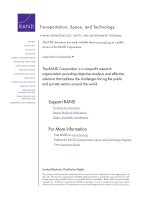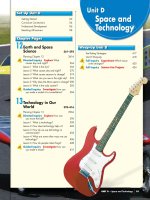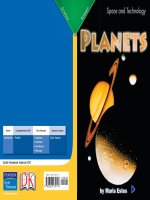Explore the galaxy (space and technology)
Bạn đang xem bản rút gọn của tài liệu. Xem và tải ngay bản đầy đủ của tài liệu tại đây (1.94 MB, 10 trang )
Suggested levels for Guided Reading, DRA,™
Lexile,® and Reading Recovery™ are provided
in the Pearson Scott Foresman Leveling Guide.
Space and Technology
Explore
the Galaxy
Genre
Expository
nonfiction
Comprehension
Skills and Strategy
• Main Idea
• Fact and Opinion
• Text Structure
Text Features
•
•
•
•
Chapter Titles
Table of Contents
Diagrams
Glossary
Scott Foresman Reading Street 2.1.2
ISBN 0-328-13237-3
ì<(sk$m)=bdcdhj< +^-Ä-U-Ä-U
by Eve Beck
Reader Response
Explore
the Galaxy
1. What was the main idea in Chapter 2?
What are some details from the chapter
that support this idea?
Main Idea
Details
Details
Details
2. How are the headings in this book
organized?
3. What is an orbit? Draw a simple picture
that shows what an orbit is.
4. What opinion do you think scientists
have of space exploration? What facts
from the book support this opinion?
by Eve Beck
Editorial Offices: Glenview, Illinois • Parsippany, New Jersey • New York, New York
Sales Offices: Needham, Massachusetts • Duluth, Georgia • Glenview, Illinois
Coppell, Texas • Ontario, California • Mesa, Arizona
CONTENTS
CHAPTER 1
4
CHAPTER 2
9
CHAPTER 3
12
NOW TRY THIS
14
Glossary
16
Our Solar System
Space Exploration
The Future
A Solar System Mobile
Every effort has been made to secure permission and provide appropriate credit for
photographic material. The publisher deeply regrets any omission and pledges to
correct errors called to its attention in subsequent editions.
Unless otherwise acknowledged, all photographs are the property of Scott Foresman,
a division of Pearson Education.
Photo locators denoted as follows: Top (T), Center (C), Bottom (B), Left (L), Right (R),
Background (Bkgd)
Opener:(Bkgd) Getty Images, (C) NASA; 1 MSFC/NASA; 6 JPL/NASA; 7 Getty Images;
8 NASA; 11 NASA; 12 NASA
ISBN: 0-328-13237-3
Copyright © Pearson Education, Inc.
All Rights Reserved. Printed in the United States of America. This publication is
protected by Copyright, and permission should be obtained from the publisher
prior to any prohibited reproduction, storage in a retrieval system, or transmission
in any form by any means, electronic, mechanical, photocopying, recording, or
likewise. For information regarding permission(s), write to: Permissions Department,
Scott Foresman, 1900 East Lake Avenue, Glenview, Illinois 60025.
2 3 4 5 6 7 8 9 10 V010 14 13 12 11 10 09 08 07 06 05
3
Chapter 1: Our Solar System
Our solar system has nine planets.
These nine planets orbit the Sun, which
means they travel around the Sun.
Earth, where we live, is one of the
nine planets. The others are Mercury,
Venus, Mars, Jupiter, Saturn, Uranus,
Neptune, and Pluto.
There are also millions of large pieces
of rock orbiting the Sun. These are
called asteroids.
This picture shows the Sun and
planets of our solar system.
Which planet is closest to
the Sun? Which is
Earth
farthest away? Can
you find Earth?
Pluto
Venus Mercury
Neptune
Uranus
Mars
Jupiter
The Sun is the center of our solar
system. The word solar means “having
to do with the Sun.” The solar system
includes the Sun and everything circling
the Sun, including the planets and
asteroids.
The Sun is actually a star. It keeps
everything orbiting around it by a force
called gravity. Each orbit is the shape of
an oval.
Sun
Saturn
4
5
The solar system also includes the
planets’ moons. Seven out of the nine
planets have moons. Earth and Pluto
have only one moon each. Mercury and
Venus have no moons. Mars has two
small moons.
Jupiter
Uranus has five large moons and
many small ones. Neptune has two large
moons and eleven smaller ones. Saturn
has more than 40 moons. Jupiter has
more moons than any other planet. It
has more than fifty moons!
Saturn
Saturn and three
of its moons
Jupiter and
one of its
moons
6
7
Chapter 2: Space Exploration
Each planet moves in its own orbit.
The planets change position as they
move. Their distance from the Sun also
changes.
Look at the diagram of Earth and
the Sun below. Use your finger to trace
Earth’s orbit.
It takes Earth 365 days to
orbit the Sun one time.
Scientists use spaceships, robots, and
satellites to explore space.
People called astronauts travel
into space. Many astronauts are also
scientists. Astronauts train for many
years to do their job. They need to be
healthy. They also need to know how
spaceships work.
Satellites are spacecraft that are sent
to orbit Earth without people on them.
We can learn new things about our solar
system from the information astronauts,
robots, and satellites bring back.
Earth
Sun
8
9
Let’s look at some space exploration
missions.
• The first satellite launched by the
United States was called Explorer 1. It
was sent into space in January 1958.
• In 1964, Mariner 4 flew by Mars.
It took the very first close-up
photographs of another planet.
Deep Space 1 was a spacecraft built
to use new equipment in space. The
mission was a success! In 2001, Deep
Space 1 flew past a comet called Borrelly
and took photographs of it to send back
to Earth.
• In 1969, the first humans landed
on the Moon. They were American
Apollo astronauts.
Comet Borrelly
Apollo 11 astronauts
walked on the Moon.
10
Deep Space 1
11
Chapter 3: The Future
An exciting mission is taking place
right now on Mars. It is called the Mars
Exploration Program. Two robots,
named Spirit and Opportunity, landed
on Mars in January 2004. These robots
are trying to learn if life could ever have
existed on Mars.
In addition to current study, scientists
are making plans for the future. One
of their plans is the Mars Science
Laboratory. A laboratory is a place
where scientific information is gathered.
The Mars Science Laboratory will be
special. It will be a robot that can gather
even more information than Spirit and
Opportunity are collecting!
Many scientists hope that we will be
able to explore more of the galaxy. A
galaxy is a huge star system. Our Sun is just
one star in a galaxy called the Milky Way.
Some people hope space travel will
be easier. By the time you are grown
up, you may be able to ascend into
space and descend back to Earth, even if
you’re not an astronaut.
This robot can drive on
the surface of Mars.
12
13
Now Try This
A Solar System Mobile
Would you like to learn the names of
all the planets and the order in which
they appear, from closest
to farthest from the Sun?
Follow these steps and
build a model of the
Sun
solar system!
Mercury
Venus
Earth
Mars
Jupiter
Saturn
Uranus
to Do It!
w
o
H
s
’
e
r
He
You will need string, poster board,
paints, scissors, a hole punch, and a
pencil.
1. First, use the information in this book
and the picture on page 14 to draw
a circle for each of the planets in
our solar system. Also, make a circle
for the Sun. The Sun should be the
biggest circle. Label each planet.
2. Carefully cut out each circle. Line up
the planets in order of distance from
the Sun. Mercury should be the first
one on the left and Pluto should be
the last one on the right.
3. Cut a different length of string for
each planet.
4. Use a hole punch to make nine holes
around the edge of the Sun. Make
one hole in the top of each planet.
Attach each planet to the Sun with
string.
Neptune
14
Pluto
15
Glossary
Reader Response
ascend v. to move
upward.
orbit v. to move
around something.
asteroids n. small
pieces of rock
orbiting the Sun.
n. the path a
planet, moon, or
satellite travels as it
circles another body
in space.
descend v. to move
downward.
gravity n. a force
that pulls objects to
Earth.
laboratory n.
a place where
scientific
information is
gathered.
16
satellites n. objects
that circle a planet
or moon, made
and put in orbit by
humans.
1. What was the main idea in Chapter 2?
What are some details from the chapter
that support this idea?
Main Idea
Details
Details
Details
2. How are the headings in this book
organized?
3. What is an orbit? Draw a simple picture
that shows what an orbit is.
4. What opinion do you think scientists
have of space exploration? What facts
from the book support this opinion?









